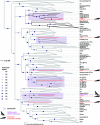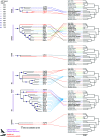Diverse papillomaviruses identified in Weddell seals
- PMID: 29469687
- PMCID: PMC5982131
- DOI: 10.1099/jgv.0.001028
Diverse papillomaviruses identified in Weddell seals
Abstract
Papillomaviridae is a diverse family of circular, double-stranded DNA (dsDNA) viruses that infect a broad range of mammalian, avian and fish hosts. While papillomaviruses have been characterized most extensively in humans, the study of non-human papillomaviruses has contributed greatly to our understanding of their pathogenicity and evolution. Using high-throughput sequencing approaches, we identified 7 novel papillomaviruses from vaginal swabs collected from 81 adult female Weddell seals (Leptonychotes weddellii) in the Ross Sea of Antarctica between 2014-2017. These seven papillomavirus genomes were amplified from seven individual seals, and six of the seven genomes represented novel species with distinct evolutionary lineages. This highlights the diversity of papillomaviruses among the relatively small number of Weddell seal samples tested. Viruses associated with large vertebrates are poorly studied in Antarctica, and this study adds information about papillomaviruses associated with Weddell seals and contributes to our understanding of the evolutionary history of papillomaviruses.
Keywords: Antarctic; Carnivora; Leptonychotes weddellii; papillomavirus.
Conflict of interest statement
The authors declare that there are no conflicts of interest.
Figures




References
-
- Münger K, Scheffner M, Huibregtse JM, Howley PM. Interactions of HPV E6 and E7 oncoproteins with tumour suppressor gene products. Cancer Surv. 1992;12:197–217. - PubMed
Publication types
MeSH terms
Substances
Grants and funding
LinkOut - more resources
Full Text Sources
Other Literature Sources

